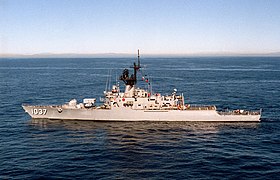Bronstein class
| Bronstein class | |
|---|---|
 USS Bronstein (FF-1037) off California |
|
| Overview | |
| Type | frigate |
| units | 2 ( USS Bronstein , USS McCloy ) |
| Namesake | Lieutenant Ben Richard Bronstein |
| Technical specifications | |
| displacement |
2,650 ts |
| length |
113.2 meters |
| width |
12.3 meters |
| Draft |
7.0 meters |
| crew |
16 officers, 183 sailors |
| drive |
1 propeller, 1 gear turbine, 2 boilers; 20,000 wave horsepower |
| speed |
26 knots |
| Range |
3,000 nautical miles at 20 knots |
The Bronstein-class frigates had been developed in the mid-1950s in response to the improved Soviet submarines . They were one of the smallest ocean-going warship classes in the United States Navy , due to the lack of space and the lack of opportunities for improvement, it remained with two units of the class.
history
In the mid-1950s it became apparent that the previous submarine weapons and ships were no longer sufficient for locating and fighting the ever faster and quieter Soviet submarines. With the development of the ASROC -U fighter missiles and the DASH drones , two new, powerful weapons were available that were used by the Bronsteins for the first time on light escort ships. The ships were designed around the new SQS-26 bow sonar , which remained the main location system until the introduction of the SQR-15 tow sonar in the mid-1970s. During construction, however, it was already apparent that helicopters would play an important role in fighting submarines in the future, but the Bronsteins did not have the space to permanently accommodate a helicopter. In addition, the large bow sonar had a negative effect on the performance and the Bronsteins were too slow for larger submarine units. It remained with two ships, the Bronstein and the McCloy , which were completed in 1963 at Avondale Shipyards . They served in the Navy until 1990 , when they were decommissioned and sold to Mexico in 1993 , where they are still in service today.
technology
Hull and drive
The hull of a Bronstein is 113.2 meters long and 12.3 meters wide. With a draft of 7.0 meters, she displaces 2,650 ts . The front third of the tapering hull is occupied by the sonar operations rooms, the deckhouse extends over the middle third of the ship. Behind the deckhouse is the drone and helicopter landing pad; the associated drone hangar is located in the rear part of the superstructure, but it was too small to accommodate a LAMPS-I helicopter. The aft part of the fuselage was lowered again, on it was first another gun, later the tow sonar.
It was driven by a geared turbine from Westinghouse, which received its steam at 40 bar from two steam boilers from Foster-Wheeler . The power of 20,000 shaft horsepower was transferred to a shaft with a screw, the maximum speed was 26 knots . The fuel supply was 480 tons, at 15 knots the range was 4,000 nautical miles.

Armament
The main armament of the Bronsteins was the eight-cell ASROC launcher in front of the bridge. In front of it was a 7.6 cm twin gun under full protection for air defense and for use against sea targets. When it was commissioned, there was another single 3-inch gun aft, but it was soon removed. In addition, the Bronsteins had swiveling Mk 32 U-Jagd triple torpedo tubes for Mk 46 torpedoes at the height of the superstructure on each side .
A DASH drone was planned as a further anti- submarine weapon, but these proved to be too unreliable in use and were quickly decommissioned. The Bronsteins did not have enough space to permanently station a manned helicopter, so that anti-submarine helicopters only came on board for missions with ships that had hangars.
electronics
Main sensor of the ships was the SQS-26 - Bugsonar whose Sonarwulst for the characteristic bow wave of Bronstein was responsible. For aerial reconnaissance they had a PLC 40 - Radar , the navigation radar was an SPS-10 from Raytheon . A Mark 56 with a range of 25 km was available as the fire control system for the twin gun, while the ASROC launcher was controlled by a Mark 114 . Mid-70s was on the quarterdeck a SQR-15 TASS (Towed Array Surveillance System) - towed array sonar installed.
See also
Web links
Footnotes
- ↑ a b gyrodynehelicopters.com
- ↑ a b Terzibaschitsch: Sea power USA. Bechtermünz Verlag, Augsburg 1997, ISBN 3-86047-576-2 , page 483
